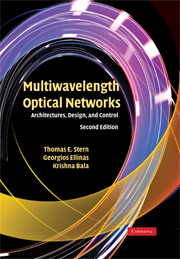Book contents
- Frontmatter
- Contents
- Figures
- Tables
- Preface to the Second Edition
- Acknowledgments
- Multiwavelength Optical Networks
- 1 The Big Picture
- 2 The Layered Architecture and Its Resources
- 3 Network Connections
- 4 Enabling Technology
- 5 Static Multipoint Networks
- 6 Wavelength/Waveband-Routed Networks
- 7 Logically-Routed Networks
- 8 Survivability: Protection and Restoration
- 9 Optical Control Plane
- 10 Optical Packet-Switched Networks
- 11 Current Trends in Multiwavelength Optical Networking
- A Graph Theory
- B Fixed Scheduling Algorithm
- C Markov Chains and Queues
- D A Limiting-Cut Heuristic
- E An Algorithm for Minimum-Interference Routing in Linear Lightwave Networks
- F Synopsis of the SONET Standard
- G A Looping Algorithm
- Acronyms
- Index
11 - Current Trends in Multiwavelength Optical Networking
Published online by Cambridge University Press: 05 June 2012
- Frontmatter
- Contents
- Figures
- Tables
- Preface to the Second Edition
- Acknowledgments
- Multiwavelength Optical Networks
- 1 The Big Picture
- 2 The Layered Architecture and Its Resources
- 3 Network Connections
- 4 Enabling Technology
- 5 Static Multipoint Networks
- 6 Wavelength/Waveband-Routed Networks
- 7 Logically-Routed Networks
- 8 Survivability: Protection and Restoration
- 9 Optical Control Plane
- 10 Optical Packet-Switched Networks
- 11 Current Trends in Multiwavelength Optical Networking
- A Graph Theory
- B Fixed Scheduling Algorithm
- C Markov Chains and Queues
- D A Limiting-Cut Heuristic
- E An Algorithm for Minimum-Interference Routing in Linear Lightwave Networks
- F Synopsis of the SONET Standard
- G A Looping Algorithm
- Acronyms
- Index
Summary
Despite the fact that optical fiber communications has been an active area of research since the early 1970s and optical transmission facilities have been widely deployed since the 1980s, serious activity in optical networking did not reach beyond the laboratory until the 1990s. It was in the early 1990s that a number of ambitious optical network testbed projects were initiated in the United States, Europe, and Japan. Although the testbeds were largely government financed, they planted the seeds for subsequent commercial developments, many of which were spin-offs of the testbed activities. The commercial ventures benefited from the knowledge accumulated from the testbeds as well as from the burgeoning worldwide demand for bandwidth. As a result, multiwavelength optical networks are deployed today in metropolitan area as well as wide area applications with increasing current activity in local access as well. In this chapter we give an overview of current developments in metropolitan and wide area networks. Recent developments in access networks were discussed in detail in Chapter 5. The chapter begins with a brief discussion of the role of business drivers and relative costs in creating the current trends. This is followed by a summary of the early testbed projects in the United States and Europe, which provides the context for a description of current commercial activity in multiwavelength metro and long-haul networks. We continue with a discussion of new applications and services made possible by the unique features of intelligent optical networks, and conclude with some thoughts for the future.
- Type
- Chapter
- Information
- Multiwavelength Optical NetworksArchitectures, Design, and Control, pp. 828 - 868Publisher: Cambridge University PressPrint publication year: 2008

